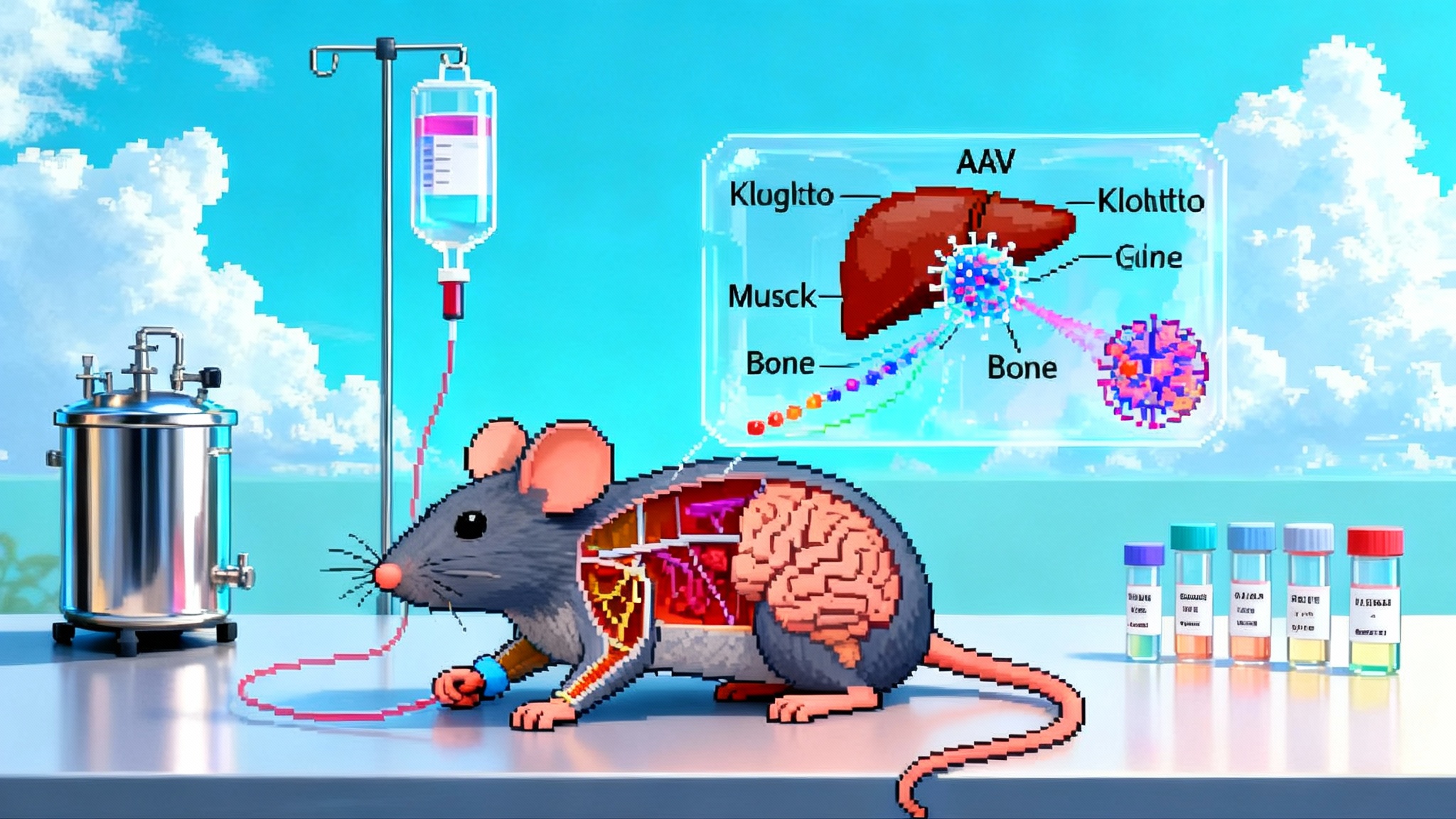GLP-1s, Healthspan, and a 6.4% Mortality Reset by 2045
Swiss Re modeling suggests GLP-1 drugs could reduce U.S. mortality up to 6.4 percent by 2045. With new Phase 3 data on oral semaglutide, we unpack biology, durability, biomarkers, trials, payer models, and equitable access.

A forecast that reframes longevity at population scale
On September 17, 2025, Swiss Re released modeling that stunned even optimists in metabolic health. In its optimistic scenario, broad use of GLP-1 therapies could reduce U.S. cumulative all-cause mortality by up to 6.4 percent by 2045. That headline number is not a boutique longevity claim, it is an actuarial view of how a single therapeutic class could bend national survival curves if uptake, adherence, and supportive lifestyle shifts take hold. See Swiss Re’s 6.4% projection.
The implications are radical. For the first time, a mass-market drug class may function as a de facto longevity intervention, moving healthspan and lifespan at scale without asking people to enroll in specialized clinics or adopt exotic protocols. To understand why, we need to look under the hood of GLP-1 biology, examine durability versus side effects, then translate that into trial design, payer models, and equitable access.
What GLP-1s actually do to bodies and risk
GLP-1 receptor agonists activate pathways that influence satiety, gastric emptying, and insulin signaling. That shorthand risks underselling their systems-level effects. The broad picture is fourfold:
- Adiposity reduction: Caloric intake drops, visceral and hepatic fat stores decline, and ectopic fat in organs falls. Fat loss at the level of the liver, pancreas, and myocardium is not just cosmetic. Less fat means less lipotoxic stress, improved insulin sensitivity, and a calmer inflammatory tone. Visceral fat is tightly linked to cardiometabolic risk, so moving it down changes baseline risk across conditions that currently drive midlife mortality.
- Inflammation downshift: When people lose visceral fat and improve glycemic dynamics, markers like hsCRP, IL-6, and leptin typically fall, while adiponectin rises. That translates to a lower background inflammatory set point. Lower inflammation is not a cure for aging, but it reduces the propellant behind atherosclerosis, heart failure with preserved ejection fraction, and a range of degenerative conditions.
- Hepatic and renal effects: Declines in liver fat map to better ALT and AST and a more favorable metabolic profile. In the kidney, improving blood pressure, glycemia, and weight can slow albuminuria progression and improve eGFR slope. Clinical trials have shown meaningful kidney benefits in high risk groups, and the mechanistic logic points to similar protection in broader populations when adherence is sustained.
- Vascular remodeling light: GLP-1s are associated with improvements in endothelial function and reductions in blood pressure and atherogenic lipids. Less glycemic variability plus weight loss likely reduce oxidative stress in the endothelium, helping arteries behave younger. For complementary lipid risk reduction, see how one-shot LDL editing could pair with metabolic therapies.
None of these effects are magic. They are compounding marginal gains that push the body toward a lower risk equilibrium. That is exactly the profile that actuaries can model.
The pill that could widen the funnel
Injectables have dominated the first phase of GLP-1 adoption. The next wave lowers friction. The Phase 3 OASIS 4 trial of an oral semaglutide 25 mg pill in adults with obesity reported an average 16.6 percent weight loss at 64 weeks among adherent participants, with a safety profile consistent with the class. The results were published in The New England Journal of Medicine. See the NEJM OASIS 4 study.
If approved, a daily pill removes the needle barrier, which matters for adoption, stigma, and logistics. Oral dosing will not solve cost or supply constraints on its own, but it could normalize chronic metabolic therapy the way statins normalized lipid management. For longevity thinking, pills shift GLP-1s from a specialty product to a primary care habit. That is how population curves change.
Durability versus side effects, the honest tradeoffs
The dream scenario is long-term cardiometabolic risk reduction with minimal adverse effects. The real world is a negotiation:
- Gastrointestinal side effects are common early on, especially during dose escalation. Nausea, vomiting, constipation, and diarrhea drive discontinuation. Step-up schedules, slower titration, and food pairing strategies help.
- Gallbladder events and rare pancreatitis occur. Clinicians already screen for risk factors, and patients should be told what to watch for.
- Weight regain is common after discontinuation. That cuts directly against the mortality math, since risk creeps back toward baseline when weight returns. Programs that pair GLP-1s with nutrition, resistance training, sleep, and stress guidance can improve durability.
- Lean mass is precious. Rapid fat loss can take some lean tissue with it. A simple prescription helps: keep protein intake adequate for body weight and train with progressive resistance two to four times weekly. The target is a healthier body composition, not just a lighter number.
Practical takeaway: GLP-1s are not set-and-forget therapy. They are tools that work best when embedded in behavior change and when clinicians personalize dosing and expectations.
From biology to biomarkers: how to measure healthspan gains
If we want to position GLP-1s as a first mass-scale longevity intervention, we need aging-relevant metrics that are feasible in routine care. A pragmatic biomarker panel for 6 to 24 month horizons could include:
- Body composition and fat distribution: DXA for fat mass and lean mass, or bioimpedance where DXA is not available; waist circumference every visit. Optional MRI-PDFF in metabolic clinics to quantify liver fat when the question matters.
- Glycemia: fasting glucose, HbA1c, fasting insulin or C-peptide, and a calculated insulin sensitivity index. Continuous glucose data adds insight into variability, which is not just a diabetes story.
- Inflammation: hsCRP as a minimal viable marker; IL-6 where practical.
- Lipids and lipoproteins: standard panel plus apoB to capture atherogenic particle number.
- Hepatic and renal: ALT, AST, GGT, bilirubin, albumin, eGFR, creatinine, cystatin C, and UACR for microvascular risk.
- Vascular function and hemodynamics: resting blood pressure, pulse pressure, and where feasible, pulse wave velocity or carotid-femoral stiffness measures; simple 6 minute walk test for functional capacity.
- Physical performance and quality of life: grip strength, chair stand, and a validated instrument like IWQOL-Lite-CT or SF-36 physical function.
For aging studies, combine these into a composite Metabolic and Vascular Healthspan Index that weights adiposity, inflammation, kidney function, and vascular stiffness. For context on measurement infrastructure, see how longevity biomarkers return to clinics.
Trial design that answers the right questions
We already know GLP-1s improve weight and glycemia. The next phase should answer four questions that matter for public health and payers:
-
How much benefit is explained by fat loss versus drug-specific effects? Design trials with stratified targets where some cohorts achieve similar fat loss through lifestyle programs. If risk reduction is similar at matched fat loss, that supports fat-centric risk pathways. If drug arms outperform at equal fat loss, that points to direct vascular or inflammatory effects.
-
What is the optimal maintenance strategy? Randomize successful responders to continued full dose versus tapered maintenance versus intermittent dosing. Measure weight trajectories, biomarker stability, and patient-reported outcomes over 2 to 3 years. The winning schedule becomes the standard for cost control and adherence.
-
What happens when patients stop? Build discontinuation substudies with structured off-ramps and rescue criteria. Quantify regain kinetics and the biomarker rebound. This informs payer policies about restart rules and patient counseling.
-
Which subgroups capture the most absolute risk reduction? Prioritize enrollment of adults with obesity plus established cardiovascular disease, chronic kidney disease, or fatty liver with fibrosis. Absolute risk is high, so absolute benefit is likely bigger, which matters for both ethics and economics.
Endpoints should include composite cardiovascular events and validated kidney outcomes in higher risk cohorts, with biomarker composites and functional measures in broader populations. For lessons on pragmatic endpoints and adherence signals, compare with year-long rapamycin trial insights. That is how we connect a clinic visit to an actuary’s spreadsheet.
Payer models that reward durability, not just initiation
If the mortality curve is going to bend, the money has to line up with long-run adherence and real outcomes. Simple rules help:
- Outcomes-based contracts: Link net price to 12 month persistence, predefined weight thresholds, and improvements in hsCRP, apoB, or UACR, depending on comorbidity. Keep metrics simple and auditable.
- Value-based care bundles: Pair GLP-1s with nutrition coaching, resistance training programs, and sleep support. The bundle is cheaper than dose escalations and discontinuation churn.
- Primary care integration: Make refills contingent on quarterly vitals, labs, and a brief adherence and side effect check. Reduce friction, keep a feedback loop.
- Step therapy that makes sense: Allow direct access for high risk groups, for example obesity plus atherosclerotic cardiovascular disease or CKD. Others can start with lower doses and structured lifestyle support before escalating.
- Adherence nudges: Text prompts in the first 12 weeks, a human touchpoint during titration, and clarity about when to pause during illness. Small investments, big retention gains.
Equitable access is a healthspan multiplier
GLP-1s cannot be a longevity tool for the few. Equity work starts with coverage, but it also includes culturally tailored coaching, clinic hours that fit shift work, language access, and clear expectations about side effects. An oral option could help patients who will not use injections, but affordability remains the gate. Public payers and self-insured employers can pilot programs in communities with high cardiometabolic burden, tying copays to engagement in supportive services. The return shows up in fewer admissions and better workforce participation.
How the Swiss Re math could be right, and what could break it
Why the 6.4 percent projection might materialize:
- Risk factor leverage: A large share of midlife deaths flow through obesity, atherosclerosis, heart failure, stroke, and kidney disease. GLP-1s push on several of these at once.
- Adoption tailwinds: More prescribers are comfortable with the class, patient demand remains strong, and an oral formulation lowers barriers.
- Systems learning: Clinics are building playbooks for dose escalation, side effect management, and pairing with strength training and higher protein diets. That turns early dropouts into long-term users.
Where it could stall:
- Discontinuation and regain: If adherence wanes and weight returns, the population benefit shrinks.
- Cost and supply: Sticker prices and production constraints cap access. Without creative contracting and manufacturing scale, uptake plateaus below what the model assumes.
- Risk drift: If prescribers reach for GLP-1s in low risk groups while high risk patients face barriers, the mortality effect dilutes.
The model is not a prophecy. It is a map that tells us which levers matter.
Practical guidance for clinicians and programs
- Start slow, personalize titration, and normalize early side effects. Many can be prevented with patient education on meal size, hydration, and timing.
- Track body composition, not just weight. If lean mass is falling too fast, pause dose escalation, add resistance work, and reassess protein intake.
- Align labs with the risk story. Check hsCRP, apoB, UACR, and standard metabolic panels. Show patients their trends, not just their targets.
- Plan the maintenance phase at initiation. Patients who understand that weight control is a long game are less likely to stop abruptly.
The bigger picture for longevity
It is possible that GLP-1s become the first mass-scale longevity tool that people use in ordinary life with ordinary doctors. Not a boutique treatment, not a biohacking protocol, but a boring, powerful lever for the middle of the risk distribution. The mortality math suggests that if access widens, if adherence is supported, and if programs help preserve muscle and function, the U.S. could see fewer premature deaths within a single generation.
We should not romanticize any single class. GLP-1s will not erase the need for blood pressure control, lipid management, sleep, movement, and mental health. They will not fix food deserts or work stress. But they do something rare in public health, they shift multiple risk factors at once and they do it in a way that most people can use.
The next two years will be decisive. Watch for regulatory decisions on the oral pill, real world adherence data, supply expansion, and payer experiments that tie price to persistence and outcomes. If those pieces align, Swiss Re’s actuarial curve could become a public health victory. If they do not, we will learn which bottlenecks were strongest, and we can redesign the system around them.
Either way, the GLP-1 era has moved longevity out of the lab and into clinics, homes, and grocery carts. That is the most hopeful development in aging in a long time, and it is happening at human scale.








